|
Spitfire Story: The Few
Supermarine Spitfire Mk.I
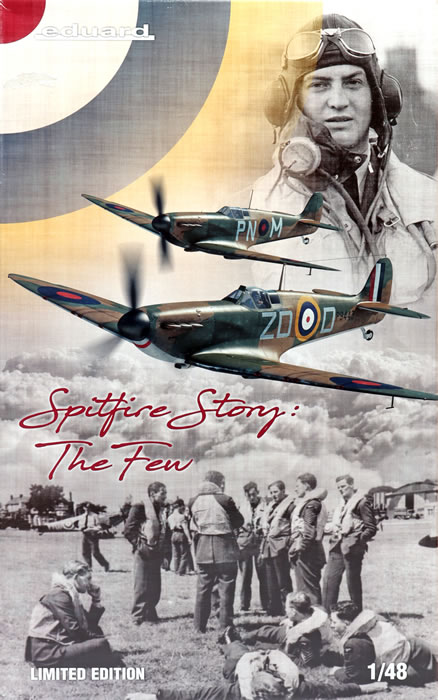
Eduard Limited Edition, 1/48 scale
S
u m m a r y |
| Catalogue Number: |
Eduard Kit No. 11143 - Spitfire Story: The Few. Limited Edition |
| Scale: |
1/48 |
| Contents and Media: |
358 parts in grey coloured plastic (58 marked not for use); 42 parts in clear (20 marked not for use); two colour photo-etched frets; self-adhesive die-cut masking sheets; markings for ten aircraft; one resin standing pilot figure (two parts in grey resin). |
| Price: |
USD$97.95 plus shipping,
available online from Eduard |
| Review Type: |
FirstLook |
| Advantages: |
Parts supplied for two full models; alternative fuselage halves for subtly different versions; high level of detail; outstanding surface
features including crisply recessed panels and subtle raised and recessed rivet lines where
appropriate; includes colour photo-etched parts; separate parts for different styles and closed and open canopies; many options for early and later production Spitfire Mk.Is. |
| Disadvantages: |
Sink marks on the exhausts; yellow of the decals looks a little pale on the sheet. |
| Conclusion: |
Eduard has waved its magic wand over this most iconic symbol of the Battle of Britain. It is great to see Eduard's outstanding surface textures and high level of detail on this 1/48 scale Spitfire Mk.I. The inclusion of options that allow different versions of the Spitfire Mk.I is very welcome too. |
Reviewed by Brett Green

The Supermarine Spitfire was the only Allied fighter aircraft of the Second World War to see front line service from the beginning of the conflict, in September 1939, through to the end in August 1945.
The Spitfire's post-war service career continued into the 1950s.
The basic airframe proved to be extremely adaptable, capable of taking far more powerful engines and far greater loads than its original role as a short-range interceptor had anticipated. This would lead to 19 marks of Spitfire and 52 sub-variants being produced throughout the Second World War and beyond.

The Spitfire Mk.I was the first production variant, fitted with eight .303 Browning machine guns in the wings. Many changes and enhancements were introduced during its production run. *
Eduard's 1/48 scale Spitfire Mk.IXc was released to justified acclaim in 2013. Over the following year or so Eduard released early and late versions as well as the Mk.XVI, plus standard and HF Spitfire Mk.VIIIs in various different packages.
Eduard has now woven its magic on the Spitfire Mk.I with their debut early-Merlin release in Dual Combo, Limited Edition guise. Parts are supplied to build two complete models - one early version and one later. If I understand the instructions correctly, you have the choice of four marking options for the early-style fuselage and six for the late fuselage.
Eduard's 1/48 scale "Spitfire Story - The Few" comprises 358 parts in grey coloured plastic (58 marked not for use); 42 parts in clear (20 parts not for use); two colour photo-etched frets; self-adhesive die-cut masking sheets; markings for ten aircraft; and one resin standing pilot figure. There are also a large number of optional parts that will remain on the sprues so the total parts per kit is really quite manageable.
Of particular note is the two sets of fuselages.
At first glance they may appear to be the same but they represent earlier and later versions.
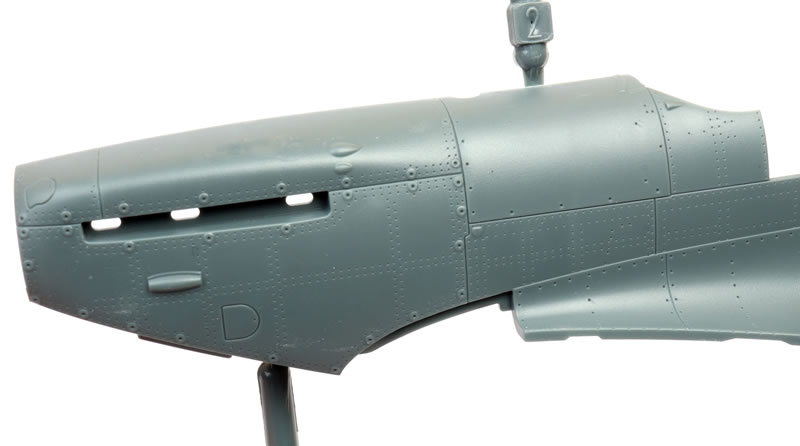
The late version is moulded with a tiny scoop on both sides of the fuselage immediately under the windscreen, a very slightly raised saddle panel representing the later 3mm armour protection for the fuel tank just in front of the windscreen, and some moulding to accommodate the external armoured glass of the later windscreen.
The early version fuselage lacks these features.

The wings are moulded as one full-span lower section and separate port and starboard upper halves.
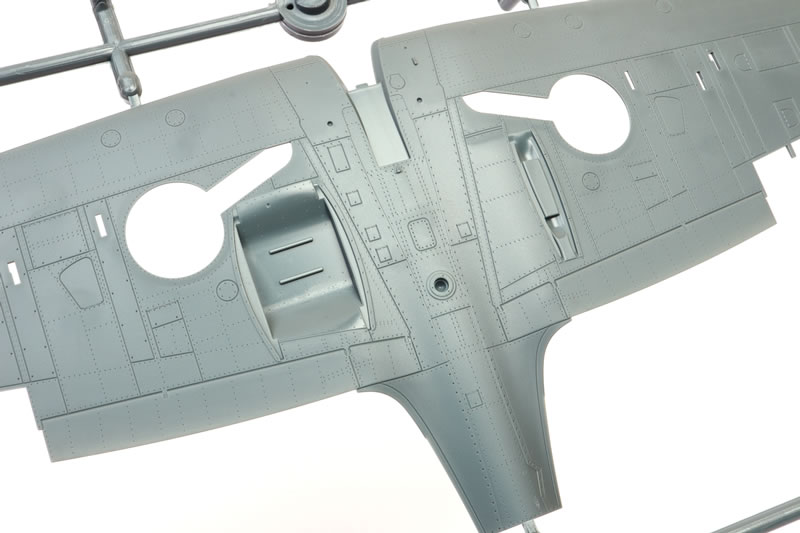
The upper wings feature the kidney shaped bulges to accomodate the main wheels. Machine gun access panels are moulded shut.
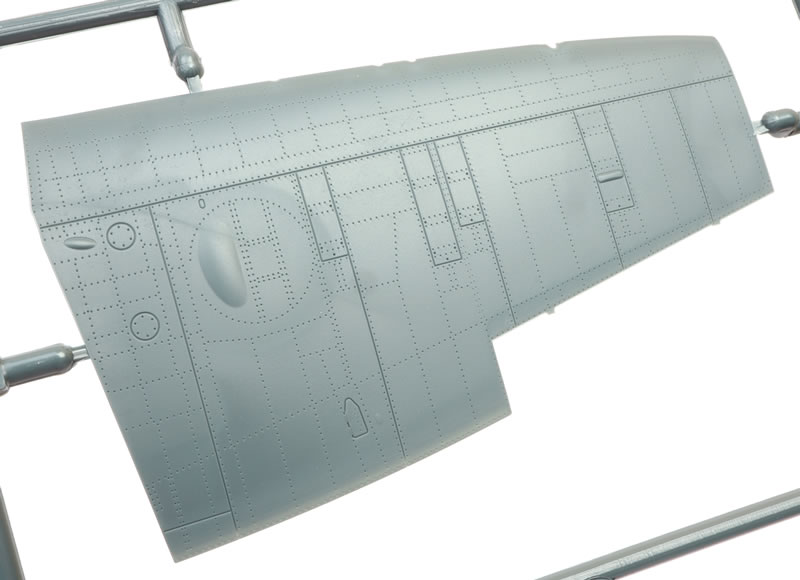
A nice touch is the locating positions inside the lower wing to fit the muzzles of the machine guns.
Detail
Eduard combines plastic and colour photo-etched parts in this Limited Edition kit, delivering a very high level of detail straight from the box. The cockpit benefits most from the photo-etch with a nice multi-layered instrument panel, coloured harness straps and scale-thickness pilot's armour.
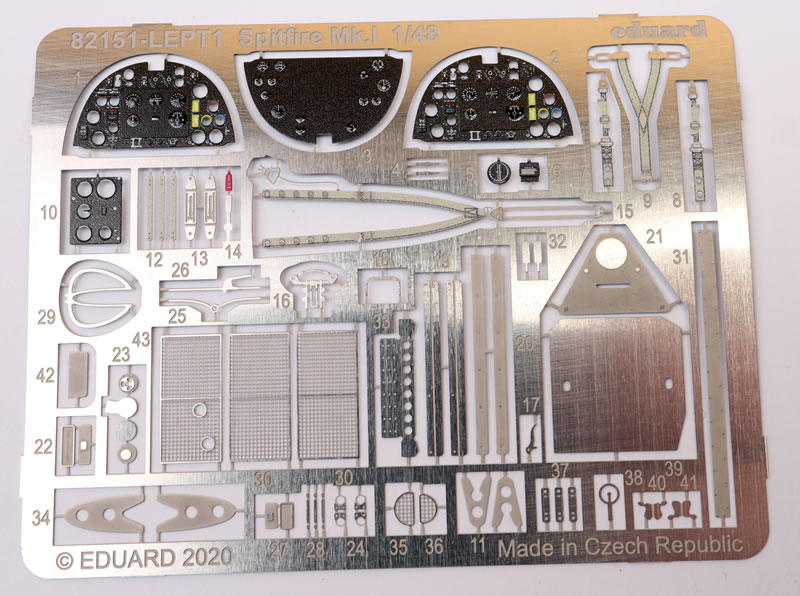
Two varieties of colour photo-etched instrument panels are offered. A plastic panel with raised bezels and a decal instrument dial layover is also included.
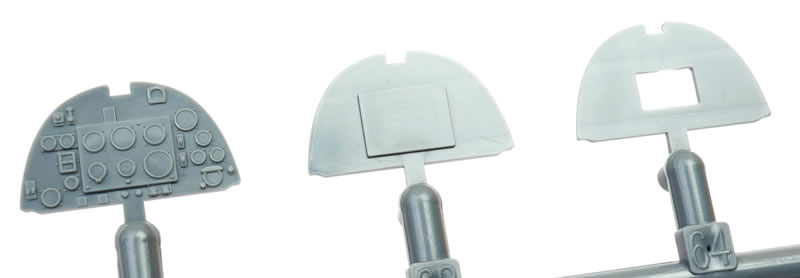
The rear bulkhead may be built with or without the pilot's head armour. Eduard has not attempted to colour the armour plate, which I think is a good call considering the amount of interpretation that might be applicable to British Interior Grey Green!
The flare rack is moulded to the front of the pilot's seat, along with an option to cut it off and replace it with a folded photo-etched part.
Eduard only supplies the early version manual undercarriage hand pump for the starboard cockpit sidewall. There seems to be some disagreement about when this manual pump was replaced with the later hydraulic system. Some sources state that the manual system was fitted to the entire Spitfire Mk.I series, while others suggest that it was replaced on the production line after about 600 aircraft were built.
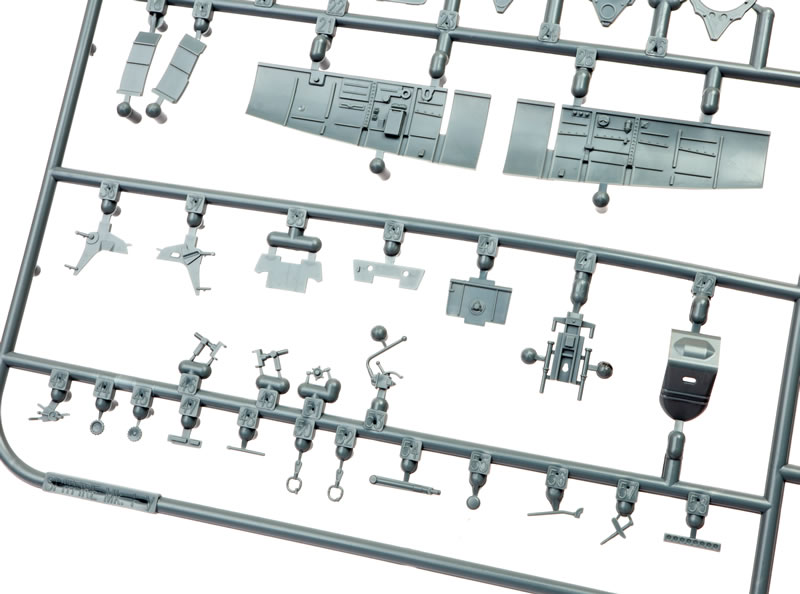
If you wish to depict the later hydraulic controls in the cockpit, both Tamiya and Airfix include this as an optional part in their latest kits. You could also use the selector in Barracuda Studios' Spitfire Mk.IX Snapshot Cockpit resin detail set. I'm pretty sure most of the other resin parts in Barracuda's set can be used on the new Eduard Spitfire Mk.I too.
The wheel wells and undercarriage parts are really well detailed.
The exhausts are the kidney type. They are supplied in one piece for each side and the stacks are hollowed out at the ends. There are sink marks on the top of my exhausts. However, if you clip the middle tab on each exhaust off, you can install them upside-down so the sink marks will be be out of sight (thanks to Tom Cleaver for that tip).

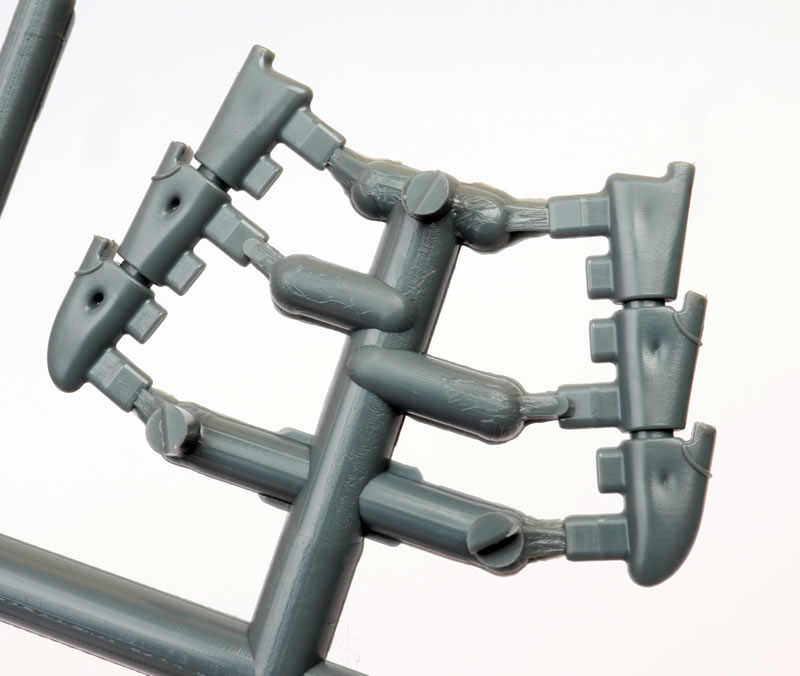
Engineering and Options
The kit is broken down conventionally. The fuselage is full-length with the only insert being the forward wing root (one part with a blister fairing and one without). The top engine cowling is split lengthwise into two pieces and two versions are offered. The instructions advise which version applies to what marking option.
The lower cowl is separate too.
The wings are also moulded without inserts.
Ailerons, elevators and the rudder are all separate, while the flaps are moulded closed. This is another sensible decision, as the flaps were rarely seen dropped at any time other than on final approach to landing. All flying control surfaces depict fabric covering.
The elevators are moulded as a matched pair, joined in the middle with a plastic connector. This will ensure that the droop (or otherwise) is consistent when the elevators are glued in place.
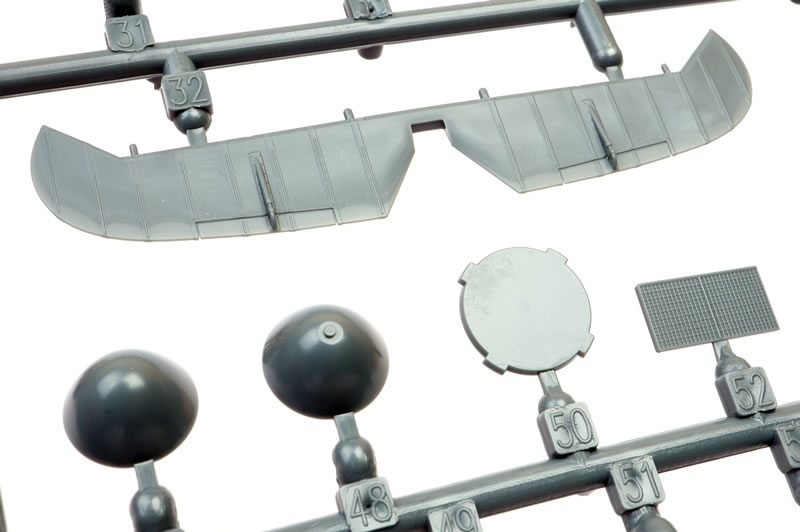
Other options include a choice of three styles of propeller - two-bladed Watts with optional spinner caps, deHavilland or two-speed metal Rotol (although don't confuse these with the later wide wooden Rotol blades fitted to the Spitfire Mk.II and Mk.V. I understand that these are metal Rotol blades only fitted to a limited number of Mk.I Spitfires), smooth or radial tread tyres, two styles of canopy, alternative antenna masts and fuselage tank sealing strips.

The canopy side door is a separate part too, with the option of posing the door open or closed.
The clear parts are free from distortion and quite thin.
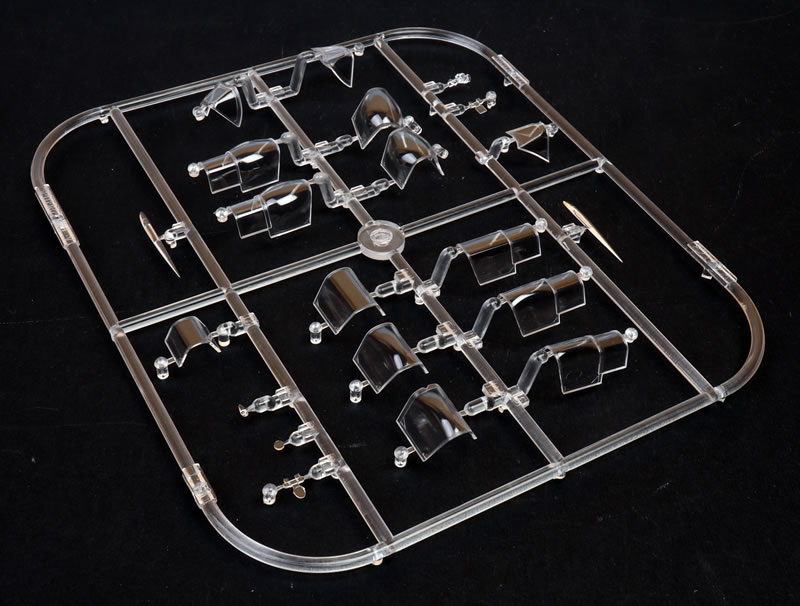
The closed canopy options comprises a combined sliding section and rear section, while the open canopy supplies a separate sliding section to sit over the rear clear part.
Surface Detail
If you have have admired the surface detail on any of Eduard's recent releases, you won't be disappointed with this one.
Panel lines are very crisp, fine and even. Lines of rivets are present, but they are subtle. The rear fuselage features a mix of domed and recessed rivets that look great.
The rivet lines seem to accurately follow the pattern applied to the full-sized aircraft too.

It is difficult to accurately portray the rivets in photographs, as studio lights tend to overemphasise them, especially on the bare plastic.
The rivets are visible on the real aircraft too, but the degree of prominence will depend on a number of factors - the gloss level of the paint, lighting, weathering, the angle and distance of the observer and more.
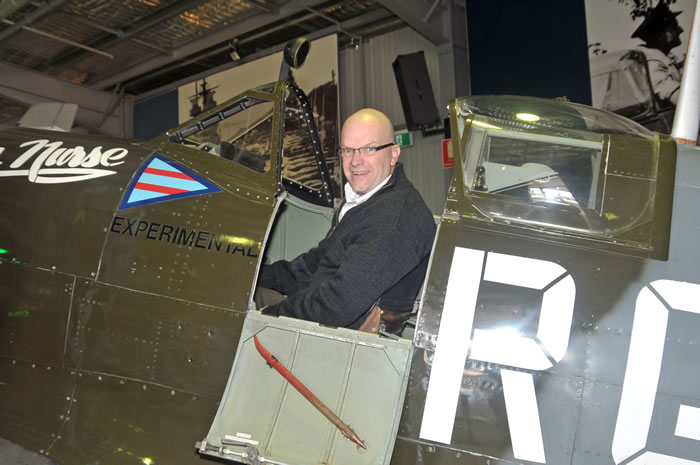
These photos show the airworthy Spitfire Mk.VIII at the Temora Aviation Museum taken during a visit in 2009. Granted, this example is glossy and restored but the rivet patterns are very obvious when viewed close-up.
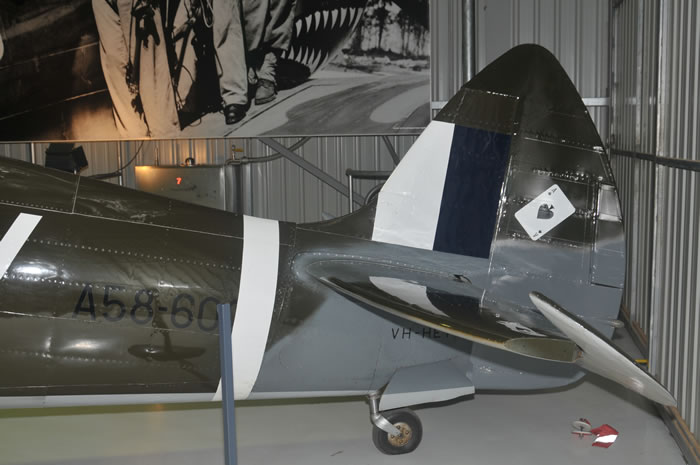
Just like on the real aircraft, after a coat of matt paint and putting a little distance between the observer and the model, the rivet detail will be almost invisible (unless you decide to emphasise it with washes and other weathering techniques, but that is entirely your prerogative!)

In my opinion, these are nicely restrained and I will definitely leave them all in place.
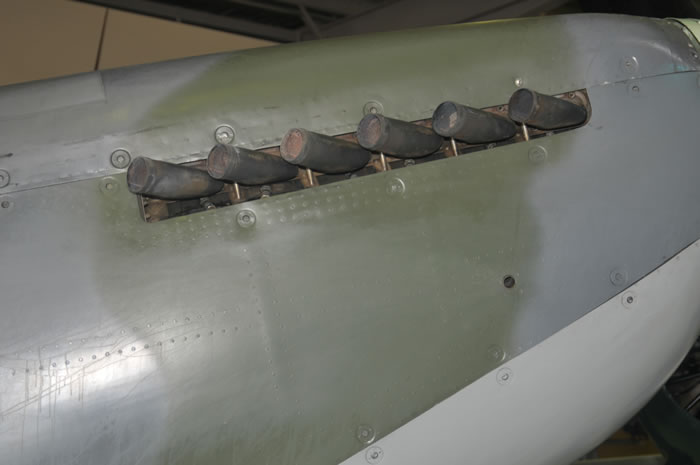
The fasteners are visible on the real aircraft (this time Temora's Mk.XVI, which features flatter paintwork) but if the raised version on the kit are not to your taste it will be a simple matter to sand them down.
Fabric detail is equally impressive, with strip and stitching texture beautifully presented on the control surfaces.
Markings
Markings are supplied for ten aircraft.
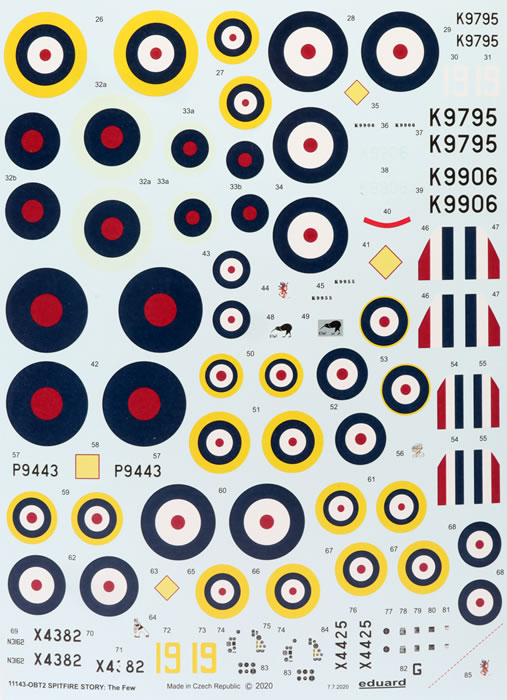
All are finished in RAF Dark Earth and Dark Green upper surfaces with lower surfaces in a range of Sky, White, Black and Silver.
-
K9795, No. 19 Squadron, RAF Duxford, Cambridgeshire, October 1938
-
No. 41 Squadron, RAF Catterick, North Yorkshire, Spring 1939
-
K9906, flown by F/O Robert Stanford Tuck, No. 65 Squadron, RAF Hornchurch, Essex, Summer 1939
-
K9955, flown by F/O Archibald Ashmore McKellar, No. 602 Squadron, RAF Drem, East Lothian, Scotland, March 1940
-
N3180, flown by P/O Alan Christopher Deere (RNZAF), No. 54 Squadron, RAF Hornchurch, Essex, May 1940
-
P9443, flown by F/Lt Douglas Bader, No. 222 Squadron, RAF Duxford, Cambridgeshire / Kirton in Lindsey, Lincolnshire, early June 1940
-
K9953, flown by F/Lt. Adolph Gysbert Malan, No. 74 Squadron, RAF Hornchurch, Essex, June/July 1940
-
N3162, flown by P/O Eric Stanley Lock, No. 41 Squadron, RAF Hornchurch, Essex, United Kingdom, August/September 1940
-
X4425, flown by F/Sgt. George Cecil Unwin, No. 19 Squadron, RAF Fowlmere, Cambridgeshire, August/September 1940
-
X4382, flown by P/O Osgood Philip Villiers Hanbury, No. 602 Squadron, RAF Westhampnett, West Sussex, September 1940.
Decals are printed by Eduard. Everything is in register on my sample but the yellow of the roundels perhaps looks a bit pale on the sheet.

I have read that these decals have a different technique, where after the decals have been applied per normal, that the carrier film may be removed. I'll report on this when I test out the decals.

Two full sets of stencil markings are included too.
The Figure
I'd love to see more pilot figures included with kits, and this one is a beauty.
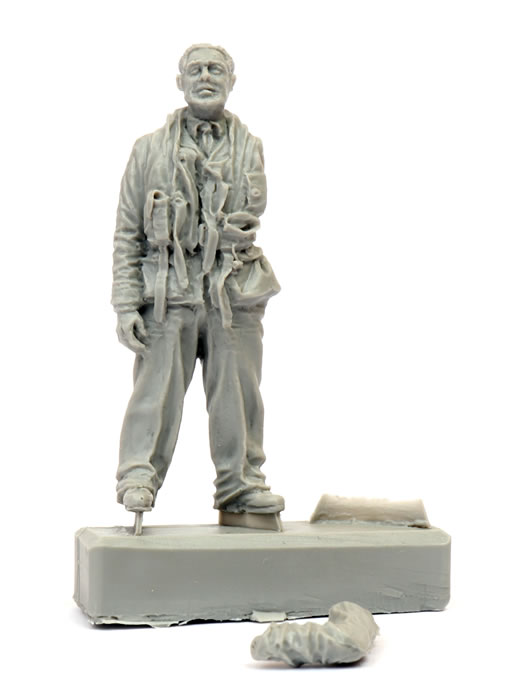
He is an early-war RAF fighter pilot in a neutral pose cast in grey resin.
His left arm is cast separately. Casting detail and sculpting are excellent.
The Spitfire Mk.I in 1/48 scale |
Prior to the release of Eduard's new 1/48 scale Spitfire Mk.I, there were a number of other offerings. Comparisons will be inevitable, so let's take a look at what else is out there now:
Revell 1978
Revell released a 1:48 scale Spitfire Mk.II in 1978. This kit could easily be backdated to a Mk.I, and often has been.
Revell’s 1:48 scale Spitfire was a very simple kit with a total of only 38 parts. Detail in the cockpit is sparse but the outlines are pretty good. The biggest problem in this regard is the absence of the characteristic “gull wing” effect at the lower trailing wing to fuselage join.
Surface texture was by way of fine raised panel lines, as was typical for its day.
The kit has been resurrected and reissued in different boxes and with alternative markings many times in the last four decades, but the plastic has remained unchanged. It has been noted that some of the detail is getting soft and flash around the parts is increasing as the moulds age.
Tamiya 1993
Tamiya launched a new range of 1:48 scale aircraft kits in 1993, with the first being a Spitfire Mk.I.
This kit was a revelation at the time in terms of fit, detail and surface features. 25 years after its initial release, Tamiya’s Spitfire Mk.I is starting to show its age.
The model comprises only around 50 parts laid out on two sprues of grey plastic and one of clear.
Options include alternate canopies, windscreens and separate pilot’s entry door. As you’d expect even from a 25 year old Tamiya kit, fit is very good. Surface detail is by way of crisply engraved panel lines and recessed holes representing rivets and fasteners.
Interior detail is not bad. Dials on the instrument panel are flat discs. The modeller can choose to paint these or apply instrument decals.
There are well-known problems with the shape of the semi-elliptical wing and the thickness of the fuselage.
Airfix 2007
In 2007, Airfix released a not-quite new 1:48 scale Spitfire Mk.I.
The kit was partially based on the old Airfix 1:48 scale Spitfire Mk.Vb, which was itself originally released way back in 1977.
New parts for this release included the entire fuselage, an all-new wing, and the specific details relating to early Merlin Spitfires.
In total, there were 77 parts in grey injection-moulded styrene plus 14 parts in clear plastic.
In contrast with the old Spitfire Mk.Vb, this Mk.I boasted recessed panel lines. These were a softer than Tamiya’s but an improvement over some of Airfix’s previous and even some subsequent efforts.
The flaps were separate parts and could be posed closed or dropped.
A Watts two-bladed propeller plus two styles of three bladed prop - de Havilland and Rotol units - were supplied, permitting the modeller to build any Spitfire from an early Mk.I to a Mk.II. The flat canopy and early-style oil cooler housing are provided for the early Mk.I, whilst Mk.II specifics such as the Coffman starter bulge are also offered in the kit. Four spoke and five spoke main wheels are included. Five spoke wheels were typical for the Mk.I through Mk.V.
The cockpit would be familiar to anyone who has built the old Airfix Spitfire Mk.Vb from the 1970s. This is one of the areas where the kit really betrays its ancestry.
In addition to the armoured and non-armoured windscreens, blown and flat canopies and rear sections for either a PR bird or a regular Spitfire, the clear sprues also contained a bubble top canopy for a low back Mk.XVI (and later) Spitfire. These clear parts were very clean, but really were too thick for a modern mainstream kit. The windscreen was especially distorted.
The general outline of the airframe in plan and profile, and the overall dimensions, correspond with published plans. The overall shape of this Spitfire is accurate.
In terms of detail accuracy, respected researcher John Adams from Aeroclub has made the following observations on HyperScale's "Plane Talking" Forum. To quote John:
- "The fuselage is very good and from the firewall back it matches on all points - windscreen, door, rear of rear view panel etc. The rudder is of correct chord and shape, with the only very minor niggles being the shape of the fin/fuselage fillet and that the rudder hinge line is 0.5mm too far aft. The wing fillets are good and of the correct width.
- The nose contours (ie thrust-line) on the Airfix Merlin family Spits are too high and although some reshaping has been done, the Mk.I nose plate is still too high by 0.75mm. Okay, most folks won't notice it.
- The wings. In 1:48 scale the Spitfire wing at its thickest point should be 7mm and this new kit comes very close. Shapewise, the trailing edge is very good.
- The leading edge at the centre gun positions is a touch too "full" and again at the very tip where the navigation light is.
- The wing root angles on model Spitfires are all different and these follow the pattern but not the drawings.
- I don't like the silly fabric sag, but a film of filler will sort this . The panel lines are fine. The trailing edges though much improved will still benefit from thinning down on the insides.
- The shape of the D.H. prop blades is good but the Rotol not so good and the Watts two blader should look the part when assembled, but watch out for the tips sweeping back."
In summary then, a bit of a Curate’s Egg – it was good in parts!
Airfix 2014
In 2014, only seven years after their initial attempt, Airfix released an all-new 1:48 scale Spitfire Mk.I.
This kit was a manifest improvement over their 2007 effort.
The new Airfix 1:48 scale Spitfire Mk.I comprises 133 parts in light grey plastic, 17 parts in clear and markings for three aircraft. There are no parts at all in common with the 1970s vintage Mk.Vb, although this kit is partly based on the lovely 2014 Airfix Spitfire Mk.Vb.
Moulding quality is very good. The plastic is smooth, and moulding imperfections are few. The most obvious is a faint vertical line on the mid-fuselage at the location of the rear cockpit bulkhead, but this may disappear under a coat of paint.
Surface detail is by way of recessed panel lines. These (and those on the 2014 Mk.Vb) are finer than those seen on any of Airfix’s immediate 1:48 scale Spitfire predecessors, although it is a bit soft in places. Fabric texture on the elevators and rudder is subtle and I like the raised fasteners on the engine cowlings.
Cockpit detail is good, and an optional seated pilot figure is included. Airfix even supplies eight .303 gun breeches to be fitted inside the wings. The instructions offer the option for the upper gun covers and the lower cover to be cut away, allowing the guns to be displayed.
Control surfaces are all supplied separately except the flaps, which are moulded closed. This is appropriate, as the flaps were generally not seen deployed except on approach and while landing. The port and starboard elevators are moulded as a single part so you can't accidentally pose them out of alignment.
The main wheels are bulged and flattened, and keyed to the axles of the undercarriage legs to ensure they sit flat on the ground. A second set of unflattened wheels are supplied for raised undercarriage. The wheel hubs are five-spoke.
The join between the undercarriage legs and the retraction part is a simple but fit with no positive locating points. Reinforcement will be helpful here.
The kit features three styles of separate “saddle” insert on the front fuselage decking for alternative windscreens, although only two options are appropriate for this version. During my build of the similar Mk.V, I found the fit was less than perfect in this area, so test-fit thoroughly before commiting to glue.
A one-piece mid and rear canopy piece is supplied for the closed option. If you want to pose the canopy open, Airfix has supplied separate overlapping parts.
In summary then, this is a very good kit of the Spitfire Mk.I that allows the modeler to build anything from an early Mk.I with two-bladed Watts propeller and the flat canopy, right through to a late Mk.I with additional head and cockpit armour.
Tamiya 2018
Tamiya released an all-new Spitfire Mk.I in late 2018. This kit had nothing at all in common with the Tamiya Spitfire Mk.I of 1999.
Tamiya's brand new 1:48 scale Supermarine Spitfire Mk.I best represents an aircraft after initial production but before the final run of Mk.Is. This model features the de Havilland propeller assembly and no pilot’s head and back armour.
The kit comprises 111 parts in grey coloured plastic, eleven parts in clear, self-adhesive canopy masks, a sheet of stickers for the canopy break-out panel and raised panels on the fuselage, polythene caps, self-adhesive masks plus markings for three aircraft.
Detail is perhaps the best I have ever seen in an all-plastic single seat cockpit. Options include alternative parts in the cockpit to depict an earlier or later version such as trim wheels and controls, two windscreens – one with separate armour and one without, early or late antenna masts and a choice of two styles of pitot tube.
Parts breakdown is fairly conventional with a couple of exceptions. The most noticeable are the large inserts in the mid-upper fuselage sides. These are provided to offer a choice between closed canopy and pilot’s entry door, or open canopy and pilot’s entry door. The open insert option is moulded with a recess so that the canopy does not ride high over the spine as almost every other Spitfire cockpit does (the newest Airfix kit gets around this problem but in a different way).
Photo-etched harness straps are included. Previous Tamiya photo-etched frets have tended to be hard metal, but this fret is soft and quite malleable, making it easy to bend the straps to shape.
Tamiya also includes a nicely crafted seated pilot figure. A separate set of partial harness straps are supplied if you choose to use the pilot.
The wings comprise a full span lower section and separate upper halves with the wheel bulge accurately recessed into the ceiling.
Ailerons and the rudder are moulded separately but they fit best in their neutral positions. The elevators are moulded onto the upper halves of the horizontal stabilisers.
Undercarriage legs are unique. The two legs are moulded as a single part, which ensures the correct rake and splay, which can often be tricky to master on Spitfire models. This is glued into a recess in the lower wing and covered by a separate panel. Of course, this means that you will have to paint the model before fitting the undercarriage legs, but fit is so good that this is not a problem.
Self-adhesive masks are provided for the canopy. As is usual with Tamiya masks, the outlines are printed onto the Kabuki-tape masks and the modeller is required to cut out the shapes.
Side-by-Side Summary
Of all the 1/48 scale Spitfire Mk.Is available at the moment, the three most recent - Eduard 2020, Tamiya 2018 and Airfix 2014 - are well in front of the rest of the pack.
Being all-plastic kits, the Airfix and Tamiya Spitfires have enough in common to easily compare. Both kits offer useful options to depict earlier or later versions of the Spitfire Mk.I. However, Tamiya's overall level of detail, and the cockpit in particular, is superior to Airfix. Surface detail is crisper too, although both kits share a similar philosophy of relatively simple recessed panel lines rather than a mass of rivets.
Also, Tamiya's building experience is sublime, while there a couple of fit challenges on the Airfix kit.
Eduard has taken a different approach that includes cockpit detail enhanced with photo-etched parts and fine lines of intricate rivets.
In the end, I think that Tamiya and Eduard are the easily the top of the heap.
Which kit is "better" will largely depend on the modeller's personal preference. If you prefer fine recessed rivets and photo-etched parts you will lean toward Eduard. On the other hand, Tamiya's crisp plastic cockpit detail and clever engineering has a lot going for it too.
Me? I'll very happily build both!
I have already built two of the Tamiya 1/48 scale Spitfire Mk.I kits and a few Eduard 1/48 scale Spitfire Mk.VIII, IX and XVIs. Each model brings its own unique joy to the modelling bench.
Ain't choice grand?
Eduard has waved its magic wand over this most iconic symbol of the Battle of Britain.
It is great to see Eduard's outstanding surface textures and high level of detail on the Spitfire Mk.I.
The inclusion of options that allow different versions of the Spitfire Mk.I is very welcome too.
History suggests that these Limited Edition kits often sell out quickly so grab yours while you can!
Thanks to Eduard for the sample
Review Text Copyright © 2013 by
Brett Green
Page Created 31 August, 2020
Last updated
1 September, 2020
Back to HyperScale Main Page
Back to Reviews Page |
